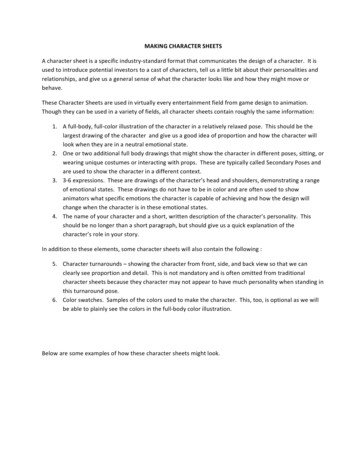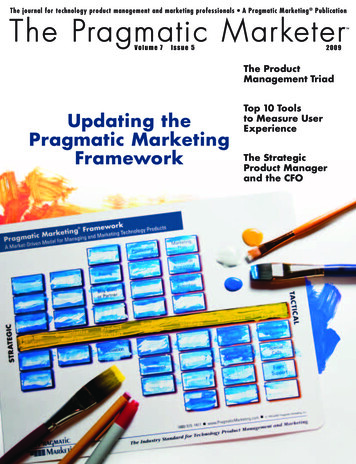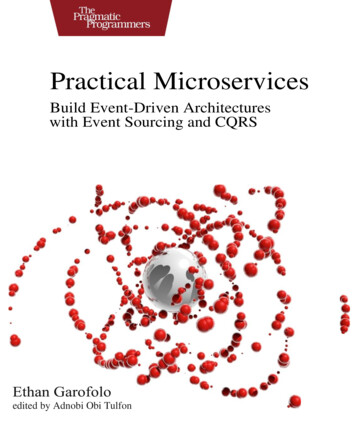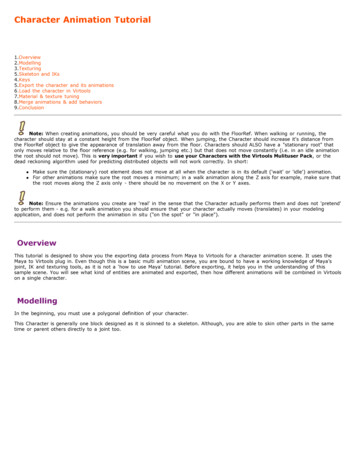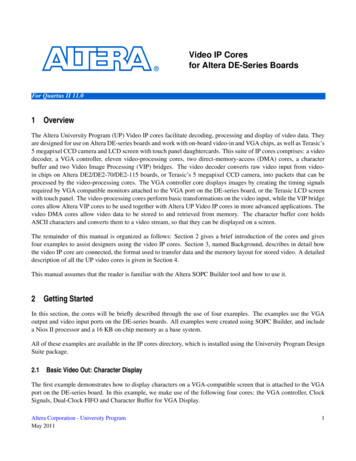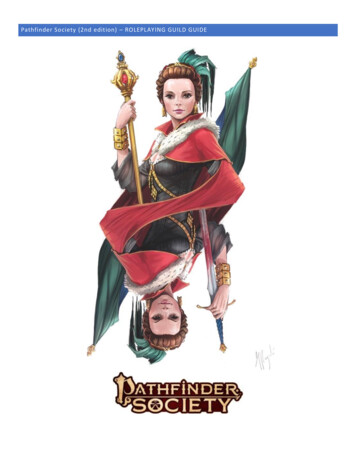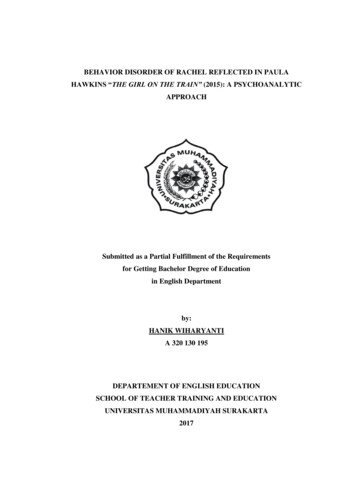
Transcription
THE MAJOR CHARACTER’S PRAGMATIC REASONS OF BECOMINGA PROSTITUTE IN PAULO COELHO’S ELEVEN MINUTES (2003)PUBLICATION ARTICLESubmitted as a Partial Fulfillment of the Requirementfor Getting the Bachelor Degree of Education in English Departmentby:Hasna Anggi RozanaA320160095DEPARTMENT OF ENGLISH EDUCATIONSCHOOL OF TEACHER TRAINING AND EDUCATIONUNIVERSITAS MUHAMMADIYAH SURAKARTA2020
iii
iiiii
iviii
THE MAJOR CHARACTER’S PRAGMATIC REASONS OF BECOMINGA PROSTITUTE IN PAULO COELHO’S ELEVEN MINUTES (2003)ABSTRAKPenelitian ini menyelidiki isu mengenai alasan-alasan pragmatis menjadi seorangpelacur yang tergambarkan dalam novel Eleven Minutes karya Paulo Coelho.Peneliti menggunakan teori pragmatisme dari William James dan John Deweyuntuk menganalisis data. Penelitian ini bertujuan untuk menyelidiki indikatorindikator terkait alasan-alasan pragmatis tokoh utama dalam menjadi seorangpelacur, mendeskripsikan isu yang tergambar dalam karya tersebut, danmenyelidiki alasan penulis dalam memilih isu pada karya tersebut. Penelitian inimerupakan penelitian kualitatif. Sumber data penelitian dibagi menjadi dua tipe.Sumber data utama adalah novel Eleven Minutes karya Paulo Coelho sementarasumber data sekunder untuk melengkapi data mencakup buku-buku literatur,jurnal, skripsi, dan sumber lainnya yang berkaitan dengan karya tersebut. Hasilpenelitian menunjukkan bahwa terdapat enam indikator mengenai alasan-alasanpragmatis menjadi seorang pelacur yang mencakup kebutuhan untuk bertahanhidup, mendapatkan kenikmatan seksual, pengambilan kesempatan yang ada,persiapan masa depan yang lebih baik, belajar masalah dan solusi, dan pencarianpengalaman baru. Penggambaran isu dideskripsikan melalui karakter, tempat,peristiwa, dan gaya penulis. Penulis tertarik untuk mengangkat isu ini karenainspirasi dari buku Irving Wallace dan fenomena nyata dari masyarakat Brasil.Kata kunci: Alasan-alasan pragmatis, Eleven Minutes, pelacur, pragmatismeABSTRACTThis study investigates the issue about pragmatic reasons of becoming a prostitutedepicted in Paulo Coelho’s Eleven Minutes novel. The researcher usespragmatism theory by William James and John Dewey to analyze the data. Thisresearch aims to investigate the indicators of the major character’s pragmaticreasons of becoming a prostitute, to describe the issue depicted in the work, and toinvestigate the author’s reason in addressing the issue in the work. This studybelongs to qualitative research. The data source is separated into two types. Theprimary data source is Eleven Minutes novel by Paulo Coelho while the secondarydata source to complete the data involves literary books, journals, undergraduatethesis, and other material from internet that is related to the work. The resultshows there are six indicators of pragmatic reasons in becoming a prostituteincluding the need for survival, getting sexual enjoyment, taking the existingopportunity, preparing for better future, learning problem and solution, andseeking for new experience. The depiction of the issue is described through thecharacter, setting, event, and author’s style. The author is interested in raising theissue because of the inspiration from Irving Wallace’s book and the realphenomenon of Brazilian society.1
Keywords: Eleven Minutes, pragmatic reasons, pragmatism, prostitute1. INTRODUCTIONThe study focuses on the issue of the major character’s pragmatic reasons ofbecoming a prostitute that is reflected in Paulo Coelho’s Eleven Minutes novel.The phenomenon of prostitution mostly is considered as a kind of exploitation ofwomen, but for certain countries it is assumed to be something very common andlegal to avoid sexual abuse. There are basic reasons that lead prostitutes to dotheir risky profession. Most of them are trapped in prostitution because ofeconomic reason. Besides that, there are other reasons such as exploitation,compulsion, environmental influence, life style, and frustration. Prostitutionbecomes attention for sociologists, religionists, government, and also the authorlike Paulo Coelho who produced the novel that is related to the issue ofprostitution entitled Eleven Minutes. Coelho received an award from Ex Librisaward Serbia for his novel in 2004 (www.merdeka.com). It is one of the bestseller novels by Paulo Coelho besides The Alchemist. It reveals the story of Maria,a Brazilian girl who works as a prostitute in Switzerland. Maria passed manyadventures in her life that resulted in the decision to become a prostitute.In accordance with the novel, the researcher has found fifteen previous studieswith various issues that have been conducted by using different theories ofliterature. In general, the previous studies toward Paulo Coelho’s Eleven Minutescan be classified into four different groups based on the theory used. Those areexistentialism theory (Ambarsari, 2018; Ningrum, 2013), sociology of literaturetheory (Ningsih, 2015), formalism theory (Anggraini, 2011), and psychology ofliterature theory with four different approaches. The four approaches involvespsychoanalytic approach (Marleni, 2010), transpersonal psychology theory(Lestari & Darma, 2014), moral development theory (Ulya, 2015), and individualpsychological approach (Antono, 2006; Pareka, 2008; Wiedaninggar, 2008;Astuti, 2014; Triutami, 2014; Puspitajati, 2015; Pratamy, 2016; Jothi, 2019).Most of the previous studies towards Eleven Minutes novel discuss on theperspective of psychology of literature, existentialism, sociology of literature, and2
formalism. While the story of the novel actually depicts a character that doessomething based on the pragmatic consideration. In the sense that the majorcharacter does not have ideals that are spiritual or religious but rather is orientedto socioeconomic benefits. So there should be a research that identifies the majorcharacter’s pragmatic reasons of becoming a prostitute.This research is close to the previous study conducted by Pareka (2008) aboutthe comparison of the main character’s motive becoming prostitute in ElevenMinutes novel and Woman at Point Zero novel. The difference is in the motivewhich underlies the decision to become a prostitute and the perspective used toanalyze the novel. The previous study uses individual psychological theory inanalyzing the data, whereas this present research uses pragmatism theory. Themotive which underlies the major character’s decision in becoming a prostitute inthe previous study is influenced by five kinds of human needs and personalitycomponent. The most influential motive is self-actualization need. It means thatthe previous study emphasizes on psychological perspective. While in the presentresearch, the motive is based on the pragmatic reasons. It means that this presentresearch emphasizes on economic perspective. Therefore, the researcherinvestigates the novel based on the pragmatism theory entitled “The MajorCharacter’s Pragmatic Reasons of Becoming a Prostitute in Paulo Coelho’sEleven Minutes (2003).”Pragmatism theory by William James and John Dewey is employed to answerthe research questions. Pragmatism is a philosophical ideology that assumes whatis right is something that proves itself to be true by looking at the effects or resultsthat are practically useful as stated by Hadiwijono (in Nurdin, 2014). Pragmatismemerged as a rejection due to the close system about absolute truth in traditionalphilosophy. The principles of pragmatism based on the combination of WilliamJames’ theory and John Dewey’s theory are believing in change & no absolutetruth, giving emphasis on experience, regenerated world or meliorism, believingin diversity, maximizing utility or utilitarianism, future-oriented, intelligence as amethod, deep faith in democracy, agreement with reality, and occurring to an idea(Putnam & Putnam, 2017).3
2. METHODThis research is a qualitative research which means that the data is formed byusing words instead of number. Qualitative research starts with supposition, theway someone thinks about the world, the probable usage of a theoretical view,and the study to investigate individual or group meaning refer to the problem ofhuman or social (Creswell, 2007, p. 37). The object of this research is ElevenMinutes novel by Paulo Coelho. The researcher uses the primary data source andthe secondary data source in completing the data analysis. The primary datasource in this research is Paulo Coelho’s Eleven Minutes novel. The secondarydata source to support the data is taken from the various sources such aspublication articles, undergraduate thesis, literary books, internet, and othermaterials related to the novel. The data collection method in this research islibrary research by using note-taking technique. The steps in collecting the data ofthis study are reading the novel repeatedly to find the issue, searching to theinternet in order to gain information related to the novel, searching the importantinformation in the novel, taking notes for collecting the important data, arrangingthe data of the research based on its category, choosing specific parts that areessential and appropriate for analysis, and making conclusion according to theanalysis. In analyzing the data, the technique has three processes namely datareduction, data display, verification and conclusion drawing (Miles & Huberman,1994, p. 10-11).3. FINDING AND DISCUSSION3.1 Finding3.1.1 The Indicators of Pragmatic Reasons of Becoming a ProstituteThe researcher has found six indicators of pragmatic reasons of becominga prostitute in Paulo Coelho’s Eleven Minutes as follows:3.1.1.1 Meeting the need for survivalThis reason deals with the everyday need of Maria which must be fulfilledfor survival. It is shown through the fact that the economic condition ofher family forces her to work hard since the income of Maria’s parents4
cannot completely fulfill her needs. Desire to earn money by workingabroad without careful consideration made her regret since the man whooffered the job had cheated her. The only way to make money easily inorder to meet her living need in Switzerland was working as a prostitutesince she had no specific skill for another job. Honor, respect, and valuewere pushed aside by her since the most important thing was being happywith a lot of money in her savings. She knew that her physical appearancecould attract the man’s desire so she took the advantage of it.3.1.1.2 Getting sexual enjoymentThis indicator is related to Maria’s experiences from childhood tilladolescence. Experience has important role in forming Maria’s future. Thefact that she was heartbroken because of the boy she loved in herchildhood made her find another way to restore her happiness. She foundthe way by doing masturbation. She did not even need anyone else tomake her happy because she could do it by herself. The curiosity to getsatisfaction and happiness continued until the age of seventeen she didsexual intercourse with her boyfriend. This occurrence then became one ofthe factors that convinced Maria to be prostitute. She became usual havingsexual intercourse with many men to get sexual enjoyment.3.1.1.3 Taking the existing opportunityIt deals with the reality that happens to Maria when she has no money tosurvive. After being dismissed by Roger as samba dancer in his nightclub,Maria became unemployed. Actually she really wanted to cope with herproblem by using her intelligence and willpower, but the Arab’s offerturned her decision. This man offered her one thousand Swiss francs if shewas willing to accompany him in the hotel. This situation then forced herto accept Arab’s offer because she needed the money for survival. It wasagreement with reality, reality that she had nothing to survive if she didnot take the opportunity from the Arab man. Through this occurrence,Maria then decided to find the location named Rue de Berne to try her luckas a prostitute.5
3.1.1.4 Preparing for better futureIt deals with the motive to increase the financial condition of Maria in thefuture. The awareness to be better in terms of economic condition becomesone of the motives that leads Maria to take a decision becoming aprostitute. This motive is shown through Maria’s ambition to improve herquality of life by having proper home, farm, cows, and business. Althoughher heart was full of pain, she was willing to be strong so her dreamswould come true. She committed to ignore her feeling in order to earnmuch money and be ready to comeback home prosperously than before.Maria wished that her life could be regenerated because she had passedand learned many things during her work in Switzerland. All she had bothmoney and knowledge would be beneficial to prepare her future life.3.1.1.5 Learning problem and solutionIt deals with Maria’s intelligence which is used to give special service forher clients. Maria’s clients mostly are businessman, politician, and peoplefrom the upper classes. The fact that her clients actually had manyproblems with their marriage and work gave her the opportunity to getextra money by giving solution and advice towards their problem. Mariacould see the opportunity that was very beneficial for her financialcondition. In order to improve her service, she even went to the library toborrow some books about psychological, marital, and political problemthat hopefully it could give better solution for them.3.1.1.6 Seeking for new experienceIt deals with Maria’s will to change in order to get new experience in herlife. The journey of her life was very constant since her parents did nothave enough money to buy all things she dreamed of. She too often saidno to the things she really wanted. With all the courage, finally Mariadecided to work abroad to change her life. She believed that her worldwould change by working in Switzerland. This perception led him tobecome a prostitute for the sake of money.6
3.1.2Depictions of Pragmatic Reasons of Becoming a ProstituteThe issue of this research is depicted through four components namelycharacter, setting, event, and style as follows:3.1.2.1 The Character3.1.2.1.1The Character of MariaMaria is the major character of Eleven Minutes novel who works as aprostitute. She never expected that the fate would lead her to become aprostitute. Maria was a naive, smart, brave, and ambitious woman. Shewas naive since she thought that someone who worked and traveledabroad would be successful. This perception was not completely right,because Maria did not think carefully when she accepted the offer towork in Switzerland. Moreover, Maria’s smartness can be seenthrough the ability to take advantage of every situation. The attitudetowards the other people who could give her benefit was nice, sweet,and pleasurable. She also learned French language to communicate andgave solution to her problematic clients. The bravery of Maria wasseen through her attitude during her survival in Switzerland. Maria wasbrave to try something new that she never did before even it was riskyfor her life. It is shown through her decision to become a prostitute inCopacabana nightclub. Maria’s ambition can be seen from her strongdetermination to face every problem in search of money. Her ambitionis also seen from her persistence to keep working in Copacabananightclub after working there in the first day.3.1.2.1.2The Evil CharacterMaria’s decision in becoming a prostitute was also influenced by theevil character Roger and an Arab man. Both of them gave contributionto Maria in taking a decision to become a prostitute. Roger and Arabman were seducer. It can be seen through their attitude towards Maria.They always gave compliments about her physical appearance. Rogerwas evil because he seduced Maria to get her acceptance working as asamba dancer in his club, yet he actually fooled Maria. While the Arab7
man who was a model agent seduced Maria to accompany him in thehotel instead of discussing about the fashion show like what he said inthe phone.3.1.2.2 SettingSetting of the story illustrates the location where Maria lives before andduring becoming a prostitute. The story takes place in two countriesnamely Brazil and Switzerland. There are two different places whichbecome the main settings in Brazil. Those are sertão and Rio de Janeiro.While in Switzerland, there are Geneva city, Rue de Berne, andCopacabana nightclub as the main settings.3.1.2.2.1Brazil3.1.2.2.1.1 SertãoSertão is Maria’s hometown. It refers to backland area in Brazil. It isdepicted in the novel that there was only one cinema and one nightclubas the entertainment place and also one bank as the public facility.3.1.2.2.1.2 Rio de JaneiroRio de Janeiro is the city that Maria dreamed of. It becomes one ofmany popular cities in Brazil since there are many artists living thereand it becomes the nice place for holiday. One of the famous areas inRio de Janeiro named Copacabana became the location where she meta Swiss man who offered her working abroad which finally made herwork as a prostitute.3.1.2.2.2Switzerland3.1.2.2.2.1 GenevaGeneva city is the location of Roger’s family nightclub which becomesthe first workplace for Maria when she works a samba dancer. Peoplewho live there call it Genève, whereas Brazilian people call itGenebra. The iconic place in Geneva is a lake with an enormousfountain in the middle.8
3.1.2.2.2.2 Rue de BerneIt is one of the popular areas in Geneva city. Rue de Berne is the nameof the street which is surrounded by sex shops, bars, and brothels. It isconsidered as the prostitution area where Maria begins to work as aprostitute. There are several nightclubs from the most expensive to thecheapest such as Copacabana, Nèon, Xenium, and Tropical Extasy.3.1.2.2.2.3 Copacabana nightclubIt is one of the most expensive places for prostitutes since most of theclients are business executives, politicians, or people from the upperclass. The prostitutes who work there are young, they are agedbetween eighteen and twenty two years old. This nightclub is ownedby Milan. Copacabana nightclub becomes the place that changesMaria’s life. There she gets many clients and new experiences.3.1.2.3 Events3.1.2.3.1Thinking of better lifeBefore Maria worked as a prostitute, she was lack of sufficiency.Dreaming to be a rich woman was the motivation for her workingabroad. She just thought that she would earn much money so she couldchange her life without deep consideration and thinking about the riskshe might get.3.1.2.3.2Survival in foreign countryAfter accepting Roger’s offer to work abroad, Maria went toSwitzerland to be a samba dancer. Apparently she was fooled by himwho promised her high salary. She was also dismissed by him so shehad no job then. Maria tried to contact a model agency which perhapswould give her a job, but it failed. Feeling frustrated by her condition,Maria then decided to be a prostitute.3.1.2.3.3Self-ExploitingThe decision to work as a prostitute made her exploit herself. Afterseveral days working in Copacabana nightclub, she began to enjoywhat she was doing. It was because of money. She chose to stay there9
longer in order to save money as much as possible although actuallyshe could go back to Brazil whenever she wanted.3.1.2.3.4Maria’s returnAfter one year living in Switzerland with many adventures, Mariacame to the decision that she had to end her dark life working as aprostitute. Before taking the decision to return home, Maria wasconfused whether she had to continue her life as prostitute or returnhome and find her true love there. But then she was aware that she hadearned much money for her future. Maria’s determination was alsoinfluenced by Ralf Hart who had taught her the meaning of sex whichwas sacred. In her return to Brazil, Maria was surprised to meet RalfHart who brought her a bunch of roses in the airport in Paris.3.1.2.4 StyleThere are six elements of author’s style in creating literary work. Theelements are sentence construction, grammatical structure, diction,figurative language, imagery, and symbolism.3.1.2.4.1Sentence construction and grammatical structureEleven Minutes is an English translated novel, so it is difficult to findthe element of sentence construction and grammatical structure sincethe novel is not in its original language form which is Portugueselanguage. Something which can be identified is the use of shortsentence instead of long sentence in constructing the story and the useof third person point of view, omniscient.3.1.2.4.2Diction3.1.2.4.2.1 Special TermThere are eleven special terms found in Eleven Minutes novelincluding sexual terms such as masturbation, orgasm, sadomasochism,pornai, peripatetica, hetaera, and other special terms such as goddessLemanjáomertà and shugendo. First,masturbation means stimulation to one’s genital in order to getsatisfaction and pleasurable feeling. Second, orgasm refers to the10
condition when someone gets the strongest pleasurable effect during orafter doing sexual activity. Third, sadomasochism is sexual activity inwhich someone gets pleasure and satisfaction by making someone elsefeeling pain physically or mentally. The next terms are pornai,peripatetica, and hetaera which are derived from Greek. Pornai isclassified as the cheapest prostitutes who work in the brothel of theowner; peripatetica is the middle class prostitutes who peddlethemselves in the street; whereas hetaera is the most expensiveprostitutes considered as female companion. Furthermore, the termsgoddess Lemanjá, graúna, andare derived fromBrazil. Goddess lemanjá is goddess of the sea while graúna is thename of Brazilian blackbird which is often used as the symbol of blackhair.is considered as a ghost of female that is cursedby God to be headless mule which vomits fire because of her sinsfornicating with the priest. The next one is omertà which belongs toItalian term. It is known as silence code to avoid law. The last isshugendo which refers to a name of ancient religion in Japan.3.1.2.4.2.2 BorrowingThe borrowings found in the novel are derived from Portugueselanguage. The borrowings are bonita, sertão, and amanhã. Bonita inEnglish means beautiful, sertão means backland, and amanhã meanstomorrow.3.1.2.4.2.3 AccentThere is one accent found in the novel which is shown through thepronunciation of two words of Portuguese language, bonita and Pelê.Bonita means beautiful, while Pelê is the name of famous Brazilianfootball player. The Swiss accent which is spoken by Roger andMaria’s friends in Switzerland sounds weird to Maria because they arenot Brazilian.11
3.1.2.4.3Figurative languageThe researcher has found five kinds of figurative language in ElevenMinutes novel. The first is hyperbole that can be seen when Mariadescribes the feeling of orgasm with exaggerate expression, “It waslike floating up to heaven and then parachuting slowly down to earthagain.” (Coelho, 2003, p. 12). Hyperbole is also shown to describehow Maria controls herself with all problems in her life by using thewords such as the earthquake and the volcano of her soul. Inpersonification Coelho uses the word “death” as if it is able to knockMaria’s door like a human and Geneva city as a face of Ralf Hart. Inmetaphor Paulo Coelho portrays that life is the same as roller coaster, adizzying game, a parachute jump, and mountaineering. It means thatlife has ups and downs. In idiom Coelho uses the phrase “vale of tears”to describe tragedy or sorrow. In simile Paulo Coelho comparesMaria’s hair with the wings of graúna (Brazilian bird) which has blackcolor.3.1.2.4.4ImageryThe researcher found six types of imagery in Eleven Minutes novelincluding the sense of tactile, visual, auditory, olfactory or smell andgustatory or taste. Tactile imagery is shown through the sexual activitywhich is done by Maria with her clients. The novel describes it clearlyincluding the activities such as hugging, touching, holding hand, andetc. Visual imagery can be seen when Maria describes the situation inRue de Berne which makes the readers imagine about that location.Auditory imagery is portrayed when Ralf Hart and Maria meet in thebar and the music in the bar is too loud so they cannot talk each otherclearly. Olfactory imagery is depicted when Ralf Hart fondles Maria’sface so Maria can smell Ralf’s body. Gustatory imagery can be seenwhen Maria tastes many kinds of food and beverage whether in Brazilor Switzerland. Taste imagery is shown when Maria feels her throat isburned by the alcohol.12
3.1.2.4.5SymbolismThere are nine symbols used to describe ideas in Eleven Minutes novel.First, the word “princess” represents Maria. The use of word“princess” indicates that Maria is beautiful and worth to be loved. Thenext symbolism is the use of word “shoes”. It represents Ralf Hart’ssituation or condition. Pebble is used as a symbol of passion for Maria.The play is a symbol of sexual intercourse done by Maria and herclients. The theatre curtain is a symbol of the clothes they wear.Yellow and red are used as the symbol of command while Maria andTerence doing sexual intercourse by practicing sadomasochism.Yellow is a code to decrease the violence and red is a code to stop it.The word “bird” is a symbol of Ralf Hart. Maria describes Ralf Hart asthe bird with perfect wings that brings happiness to people. The nextsymbol is building to indicate woman’s genital. The G-spot can befound as the same as someone enters a building on the first floor thenfinds back window.3.1.3Author’s Reason in Addressing the IssueThe author of Eleven Minutes, Paulo Coelho, was interested in creating theissue about prostitution because of the inspiration that came from IrvingWallace’s book entitled The Seven Minutes. The novel was bannedbecause of the sexual content inside it. While Paulo assumed that thesexual content inside the novel was infrequently mentioned. He wascurious about what made the book banned. Therefore, Paulo was interestedin writing the novel about sex.Furthermore, Paulo was inspired by the real story of Brazilianprostitute. In 1997 Paulo received a manuscript from Brazilian girl namedSonia (fictitious name) who worked as a prostitute in Europe. Themanuscript interested him to meet Sonia in Zurich. This occurrence ledPaulo to meet other prostitutes besides Sonia. It was motivated him towrite about sex which was usually considered to be a taboo topic. When13
Paulo attended the book-signing in Geneva, he was struck by one of theprostitutes who emerged to have the copies of Paulo’s books.Subsequently, he arranged a meeting with her and his agent which endedup in creating the thread of the novel. That was how Paulo created thenovel based on the real story of a prostitute named Maria (fictitious name)by putting the additional elements to make it more attractive (Coelho,2003, p. 273-275).In accordance with the prostitution phenomenon raised in Eleven Minutesnovel, Brazilian becomes the big participants in this matter. Paulo Coelhoas the author of Eleven Minutes is inspired by Brazilian people whoimmigrate to Switzerland in search of treasure. Most of them are womenwho are looking for better job. Schuler & Dias (2014) have found thatthere are at least 60.000 Brazilian emigrants who live there, but onlyaround 14.000 Brazilians who emigrate legally. Many of them work asdancers in the club. They who work as dancers are required to have anartist’s visa so that the government can restrict illegal emigrants. The dataalso shows that 90% of them work as prostitute. This phenomenonmotivates Coelho to address the issue about prostitution which is thenarranged in Eleven Minutes novel.3.2 DiscussionAfter examining Paulo Coelho’s Eleven Minutes, the researcher has found sixpragmatic reasons of the major character in becoming a prostitute. The firstreason is meeting the need for survival. Becoming prostitute is a way for herto maximize happiness and reduce suffering. She will get benefits which arevery useful for her to continue her life. Getting sexual enjoyment is the secondreason for Maria. Experiencing sexual activities is the way for her to behappy. Hence she is passionate about sex. The third reason is taking theexisting opportunity. The reality that she has no job to survive makes her tryher luck as a prostitute in Rue de Berne. This occurrence is agreement withreality. The next reason is preparing for better future. She wants to live14
prosperously without suffering anymore. Her ambition is to make things betterthan before. The other reason is learning problem and solution. Intelligence isused by Maria to solve social problems of her clients. The last reason isseeking for new experience. Maria is willing to change her life because life isnot constant. World is always still in the process.From the explanation above, it can be seen that Maria’s reasons inbecoming a prostitute are more pragmatic. The principles of pragmatismaccording to William James and John Dewey which are depicted throughMaria’s reasons are utilitarianism, empiricism, agreement with reality,regenerated world, intelligence as a method, and believing in change and noabsolute truth.Regarding to the author’s reason in addressing the issue, ElevenMinutes is actually has a strong connection with Brazilian people. It is areflection from the real phenomenon of Brazilian society. Brazilian womenwho immigrate to Switzerland are mostly work as dancers and prostitutes.According to Schuler & Dias (2014) Brazilian women who immigrate toSwitzerland are mostly work as dancers. But 90% of them also work asprostitutes. Many of them are considered to be illegal immigrants.This research is close to the previous study conducted by Pareka(2008) about the comparison of the main character’s motive becomingprostitute in Eleven Minutes novel and Woman at Point Zero novel. Theresearch conducted by Pareka (2008) uses individual psychological approachand the motive of becoming a prostitute emphasizes on the psychologicalperspective in which the major character influences by five kinds of humanneeds, especially self-actualization need. While t
2 Keywords: Eleven Minutes, pragmatic reasons, pragmatism, prostitute 1. INTRODUCTION The study focuses on the issue of the major character’s pragmatic reasons of becoming a prostitute that is reflected in Paulo Coelho’s Eleven Minutes novel. The phenomenon of prost


